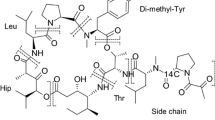Summary
The uptake of melphalan into tumour cells has been shown previously to involve active transport, while that of chlorambucil is by passive diffusion. In view of these findings, the mechanism of their gastrointestinal absorption was investigated using the in situ rat intestinal model. Segment lengths in all cases were (mean±SD) 47.2±4.7 cm. Drug absorption was monitored from control intestinal segments and from segments pretreated with the metabolic inhibitors 2,4 dinitrophenol (DNP) or carbonylcyanide-M-chlorophenyl-hydrazone (CCCP). Aliquots of gut-perfusing solution were removed at 5-min intervals over 30 min and assayed for drug using a high-performance liquid chromatography (HPLC) method selective for the alkylating agents. Absorption of melphalan by control animals was (mean±SD) 1.22%±0.25% cm-1 gut length, as against 0.59%±0.13% cm-1 in DNP- and 0.45%±0.07% cm-1 in CCCP-treated animals. Absorption of chlorambucil was 1.47%±0.17% cm-1 (control), 1.49%±0.06 cm-1 (DNP), and 1.58%±0.23% cm-1 (CCCP).
It was clear, therefore, that pretreatment of intestinal segments with metabolic inhibitors led to a reduced absorption of melphalan (P<0.01) but did not influence that of chlorambucil. The experimental data suggest that melphalan uptake from the intestine involves and energy-dependent system whereas chlorambucil is passively absorbed.
Similar content being viewed by others
References
Adair CG, Burns DT, Crockard AD, Desai ZR, Harriott M (1984) Modified extraction and chromatography for the measurement of plasma melphalan by ion pair high performance liquid chromatography. J Chromatogr [Biomed Appl] 336: 429
Adair CG, Burns DT, Crockard AD, Harriott M (1985) Determination of chlorambucil using reversed phase high performance liquid chromatography. J Chromatogr [Biomed Appl] (in press)
Alberts DS, Chang SY, Chen HS-G, Evans TL, Moon TE (1979) Oral melphalan kinetics. Clin Pharmacol Ther 26: 737
Bergal F, Stock JA (1954) Cytoactive amino acids and peptide derivatives. Part I substituted phenylalanines. J Chem Soc 76: 2409
Bosanquet AG, Gilby ED (1982) Pharmacokinetic of oral and intravenous melphalan during routine treatment of multiple myeloma. Eur J Clin Oncol 18: 355
Bosanquet AG, Gilby ED (1984) Comparison of fed and fasting states on the absorption of melphalan in multiple myeloma. Cancer Chemother Pharmacol 12: 183
Doluisio JT, Billups NF, Dittert LW, Sugita ET, Swintosky JV (1969) Drug absorption: I In situ rat gut technique yielding realistic absorption rates. J Pharm Sci 58: 1196
Dorr RT, Fritz W (1980) Cancer chemotherapy handbook. Kimpton, London, p 303
Ehrsson H, Wallin I, Simonsson B, Hartvig P, Oberg G (1984) Effect of food on the pharmacokinetics of chlorambucil and its main metabolite, phenylacetic mustard. Eur J Clin Pharmacol 27: 111
Fasman GD (ed) (1976) CRC Handbook of biochemistry and molecular biology, 3rd edn, vol I. CRC Press, Cleveland p 319
Furner RL, Brown RK (1980) L-Phenylalanine mustard: the first 25 years. Cancer Treat Rep. 64: 559
Goldenberg GJ, Lee M, Lam HYP, Begleiter A (1977) Evidence for carrier mediated transport of melphalan by L5178Y lymphoblasts in vitro. Cancer Res 37: 755
Goldenberg GJ, Lam HYP, Begleiter A (1979) Active carrier mediated transport of melphalan by two separate amino acid transport systems in LPC-1 plasmacytoma cells in vitro. J Biol Chem 25: 1057
Hill BT (1972) Studies on the transport and cellular distribution of chlorambucil in the Yoshida ascites sarcoma. Biochem Pharmacol 21: 495
Leff P, Bardsley WG (1979) Pharmacokinietics of chlorambucil in ovarian carcinoma using a new HPLC assay. Biochem Pharmacol 28: 1289
Swintosky JV, Pogonowska-Wala E (1982) The in situ rat gut technique. A simple, rapid, inexpensive way to study factors influencing drug absorption rate from the intestine. Pharm Int 5: 163
Vistica, DT (1983) Cellular pharmacokinetics of the phenylalanine mustards. Pharmac Ther 22: 379
Vistica DT, Total JN, Robinovitz M (1976) Amino acid conferred resistance to melphalan. I. Structure-activity relationship in cultured murine L-1210 leukaemia cells. Cancer Treat Rep 60: 1363
Author information
Authors and Affiliations
Additional information
The work reported in this paper was supported by the Northern Ireland Leukaemia Research Fund
Rights and permissions
About this article
Cite this article
Adair, C.G., McElnay, J.C. Studies on the mechanism of gastrointestinal absorption of melphalan and chlorambucil. Cancer Chemother. Pharmacol. 17, 95–98 (1986). https://doi.org/10.1007/BF00299875
Received:
Accepted:
Issue Date:
DOI: https://doi.org/10.1007/BF00299875




